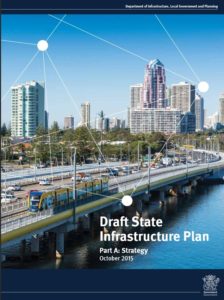
Public submissions on Queensland’s draft State Infrastructure Plan closed in December, but residents of Redlands are urged to make their views known to their State member about at least one pernicious aspect of the draft.
The plan features a new secretariat within Treasury to receive what it euphemistically calls ‘market-led proposals’, being projects that a commercial company thinks can be profitable, but that the government hasn’t previously considered.
Er, did we hear that correctly? How vital to the economy is a project that the government, with all the planning expertise at its disposal, hasn’t even contemplated?

Public transport infrastructure is traditionally developed after Government assesses needs
This turns on its head the traditional way that roads, railways, pipelines and other forms of infrastructure have been built. Traditionally, departments would first consider need – including trends in urban growth and bottlenecks in current services – as well as alternative solutions.Strategic plans would be drafted. There would be numerous inter-departmental consultations during which priorities would be evaluated, benefit-costs compared, negative side-effects anticipated and feedback sought from experts and the community.
Then departmental bids would be framed for consideration at budget time. During annual budget deliberations, ministers would compare various claims on the public purse. Infrastructure projects, already sieved by the public service, would take their place in the queue along with hospitals, schools, parks and other civic utilities. When a project had received both policy approval and budget approval, tenders would be called and the best value for money chosen.
Suction hose into Treasury

Projects need environmental assessment but will market proponents do this properly?
But the construction industry has not been content with taking its place in the queue. Now it has apparently convinced the government to bypass all of that strategic forethought and grant it a suction hose directly into Treasury. The government was not content to wait for the outcome of submissions on the draft plan, as the Premier announced this new provision on 23 September last year.
The documents argue that the government will approve of proposals only after careful assessment of environmental and community impacts. But no amount of project-specific impact assessment after an application has gained momentum can substitute for careful prior strategic land use and transport planning on a broader canvas. It seems that twenty-five years’ worth of regional land-use plans since the reforms of the Goss Labor government in 1990, drawing upon thousands of hours of good-faith input from the professions and the community, are to moulder on the shelves.
Forward planning by people who have spent their careers accumulating expertise in land-use, civic design, architecture, green space, traffic planning and community governance is to be neglected. It is not guaranteed that Treasury will even recruit people with this expertise; it is more likely that it will outsource assessment to applicants. This means that the perspective taken on projects will be narrow and their context, their setting in the landscape, especially any negative ripple consequences, will be overlooked or unrecognised.
Over-emphasis on cash flow to private operators

Toll roads qualify – Photo by Advanstra
Not only that, but market-led proposals will distort public funding decisions in another way: they are likely to lead to over-emphasis on construction projects that can deliver cash flow to private operators. Toll roads qualify. Tough luck for regional Queensland, as infrastructure projects there are rarely commercially attractive. Tough luck also for small local projects, which under traditional methods of funding might have been on the local government’s wish list as locally managed projects.
Tough luck also for public expenditure that doesn’t fit within the concept of ‘infrastructure’ as understood by Treasury. The new secretariat is unlikely to invest in ongoing funding for grassroots scientific research, education, environmental repair – and indeed, planning itself. All evidence is that investment in these forms of capacity building yield ongoing economic activity as they are the source of innovation and efficiency.
In other words, the opportunity cost of focusing on large, cash-flow generating projects is immense.
A disaster waiting to happen

Queensland Rescue Helicopter won’t be able to help when a market led project flops
If the hubris of Treasury in thinking that it can produce a better network of infrastructure by dealing directly with the construction industry isn’t bad enough, the announced intention to grant an ‘exclusive mandate’ to single favoured firms without competition is a disaster of public governance waiting to happen.
It is fashionable to ridicule town planning procedures – ‘green tape’ – as a barnacle upon progress. But the regional planning regime has been built painstakingly over decades for a purpose: to safeguard the public interest, to guide prudent decisions about what ought to be built and where, and to steer governments and business away from foreseeable mistakes.
Assurances by proponents that their projects will be a boon to the economy are a siren song. Better to reinstate the planning and research capacity of the public service and local government, which will lead governments away from the waste and scandal that is inevitable if the Market-Led Proposals Secretariat is allowed to survive.
Geoff Edwards – 8 February 2016
Adjunct Senior Research Fellow
Centre for Governance and Public Policy
Griffith University
Dr Edwards is educated in science and public policy. He has been a local government councillor and Shire President. From 1991-2011 he served as a policy manager in the Queensland Public Service in land and energy policy. His research interest lies in exploring the ‘public interest’ as a benchmark for public policy.
This article is adapted from one published in The Courier-Mail on 28 January 2016.
Please note: Offensive or off-topic comments will be deleted. If offended by any published comment please email thereporter@redlands2030.net

What a well written and well argued article.
Too bad Government itself can’t do a like job.
Perhaps it is thru that years of cuts to achieve a smaller government have got us to the stage that we now have a dumber government too.